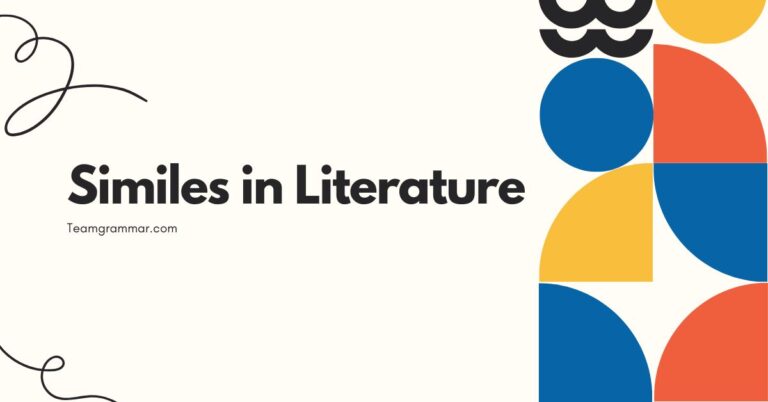40 Similes for Sky: A Comprehensive Guide to Figurative Language
Understanding similes is crucial for mastering figurative language and enhancing your descriptive writing skills. Similes add depth and vividness to your expressions by comparing seemingly unrelated things using “like” or “as.” This article focuses specifically on similes used to describe the sky, offering a detailed exploration of their structure, types, and usage.
Whether you’re a student, writer, or language enthusiast, this guide will equip you with the knowledge and tools to create compelling and imaginative descriptions of the sky.
Table of Contents
- Introduction
- Definition of Simile
- Structural Breakdown of a Simile
- Types of Sky Similes
- Examples of Similes for Sky
- Usage Rules for Similes
- Common Mistakes with Similes
- Practice Exercises
- Advanced Topics in Similes
- Frequently Asked Questions
- Conclusion
Definition of Simile
A simile is a figure of speech that directly compares two different things using the words “like” or “as.” The purpose of a simile is to create a vivid image in the reader’s mind by drawing a connection between the two seemingly unrelated subjects. Similes are a powerful tool in descriptive writing, allowing authors to evoke emotions, create atmosphere, and add depth to their narratives.
Similes are classified as a type of figurative language, specifically a type of comparison. They function to enhance understanding and create imagery by relating the unfamiliar to the familiar.
In the context of describing the sky, similes can help us visualize its vastness, color, and ever-changing nature in a more engaging and memorable way.
The contexts in which similes are used are virtually limitless. They appear in poetry, prose, song lyrics, everyday conversation, and advertising.
Wherever there is a need to add color and depth to language, similes can be employed effectively. For example, a poet might describe the sky as “blue as a robin’s egg,” while a novelist might write, “the clouds drifted like ships on a boundless ocean.”
Structural Breakdown of a Simile
A simile consists of three essential components: the subject, the linking word (like or as), and the object of comparison. The subject is the thing being described, the linking word establishes the comparison, and the object of comparison provides the point of reference.
The basic pattern is: Subject + Linking Word + Object of Comparison. Let’s examine this structure in the context of describing the sky.
For example, in the simile “The sky is as blue as the ocean,” the subject is “the sky,” the linking word is “as,” and the object of comparison is “the ocean.” This structure clearly and directly compares the color of the sky to the color of the ocean, creating a vivid image in the reader’s mind.
Understanding this fundamental structure allows you to create your own similes. By identifying the subject you want to describe (the sky), selecting an appropriate linking word (like or as), and choosing a relevant and evocative object of comparison, you can craft effective and imaginative similes.
Types of Sky Similes
Similes for the sky can be categorized based on the aspect of the sky being described. These categories include color, texture, movement, and emotional impact.
Understanding these categories can help you create more specific and impactful similes.
Similes Describing Color
These similes focus on the hues and shades of the sky. Examples include: “The sky was as blue as a sapphire,” or “The sunset was like a fiery painting.” These similes aim to capture the visual beauty of the sky’s colors.
Similes Describing Texture
These similes focus on the appearance of the sky’s surface, such as cloud formations. Examples might include: “The clouds were like cotton candy,” or “The sky was as smooth as glass.” They emphasize the tactile or visual texture of the sky.
Similes Describing Movement
These similes focus on the motion of clouds or the changing appearance of the sky over time. Examples include: “The clouds drifted like ships on the horizon,” or “The storm clouds gathered as rapidly as a closing curtain.” These similes highlight the dynamic nature of the sky.
Similes Describing Emotional Impact
These similes focus on the feelings or mood evoked by the sky. Examples might include: “The sky felt as heavy as sorrow,” or “The clear blue sky felt like a breath of fresh air.” They aim to convey the emotional connection between the sky and human experience.
Examples of Similes for Sky
Here are several examples of similes used to describe the sky, categorized for clarity. Each table provides a variety of similes that illustrate different aspects of the sky.
Table 1: Color-Based Similes for Sky
The following table presents examples of similes that focus on the color of the sky. These similes use a variety of objects and concepts to create vivid color descriptions.
| Simile | Explanation |
|---|---|
| The sky was as blue as a robin’s egg. | Compares the sky’s blue color to the specific shade of a robin’s egg. |
| The sunset was like a fiery orange. | Compares the sunset’s color to the intense color of fire. |
| The sky was as gray as a leaden sea. | Compares the sky’s grayness to the dull color of lead. |
| The dawn sky was like a pale pink blush. | Compares the dawn sky’s color to the soft, delicate color of a blush. |
| The night sky was as black as velvet. | Compares the night sky’s darkness to the rich, deep color of velvet. |
| The sky was as green as jade after the storm. | Compares the sky’s unusual green hue to the precious stone jade. |
| The sunrise was like a golden river flowing across the horizon. | Compares the sunrise to the gleaming appearance of a river of gold. |
| The sky was as white as a bleached sheet. | Compares the sky’s whiteness to the stark appearance of a bleached sheet. |
| The twilight sky was like a lavender dream. | Compares the twilight sky to the soft, dreamy color of lavender. |
| The sky was as purple as amethyst. | Compares the sky’s purple color to the gemstone amethyst. |
| The sky was like a canvas painted with hues of cerulean and gold. | Compares the sky to an artist’s canvas, highlighting the blend of blue and gold. |
| The overcast sky was as dull as a tarnished coin. | Compares the sky’s lack of vibrancy to the faded appearance of a tarnished coin. |
| The summer sky was as clear as a turquoise gem. | Compares the sky’s clarity to the vibrant blue-green of turquoise. |
| The autumn sky was like a watercolor wash of russet and ochre. | Compares the autumn sky to a watercolor painting, emphasizing its earthy tones. |
| The winter sky was as frigid as a sapphire. | Compares the sky’s coldness and color to the deep blue of a sapphire. |
| The sky was like a bruised plum after the hurricane. | Compares the sky’s dark, mottled color to the appearance of a bruised plum. |
| The morning sky was as bright as a canary’s wing. | Compares the sky’s brightness to the vibrant yellow of a canary’s wing. |
| The sky was as dark as coal before the lightning struck. | Compares the sky’s intense darkness to the blackness of coal. |
| The sky was like a kaleidoscope of colors during the aurora borealis. | Compares the sky to a kaleidoscope, highlighting the shifting array of colors. |
| The sky was as golden as honey at sunset. | Compares the sky’s warm color to the rich, golden hue of honey. |
| The sky was like a watercolor painting of soft blues and pinks. | Compares the sky to a watercolor painting, highlighting the delicate blending of colors. |
| The stormy sky was as black as ink. | Compares the sky’s darkness to the intense blackness of ink. |
| The midday sky was as blindingly white as fresh snow. | Compares the sky’s brightness to the stark whiteness of snow. |
Table 2: Texture-Based Similes for Sky
The following table presents examples of similes that focus on the texture and appearance of the sky, particularly cloud formations. These similes use a variety of tactile and visual comparisons.
| Simile | Explanation |
|---|---|
| The clouds were like cotton candy. | Compares the clouds’ fluffy appearance to the texture of cotton candy. |
| The sky was as smooth as glass. | Compares the sky’s surface to the unbroken smoothness of glass. |
| The clouds were like fluffy sheep grazing in the blue pasture of the sky. | Compares the clouds to sheep, emphasizing their shapes and the sky’s vastness. |
| The sky was as turbulent as a stormy sea. | Compares the sky’s chaotic appearance to the rough surface of a stormy sea. |
| The clouds were like brushstrokes of white paint on a blue canvas. | Compares the clouds to brushstrokes, highlighting their shape and the sky’s background. |
| The sky was as clear as crystal. | Compares the sky’s clarity to the transparency of crystal. |
| The clouds were like towering mountains of snow. | Compares the clouds’ size and whiteness to snow-covered mountains. |
| The sky was as hazy as a dream. | Compares the sky’s indistinctness to the nature of a dream. |
| The clouds were like scattered feathers floating in the breeze. | Compares the clouds to feathers, emphasizing their lightness and movement. |
| The sky was like a rippled silk sheet stretched across the world. | Compares the sky’s texture to the smooth, undulating surface of silk. |
| The clouds were as dense as a forest of trees. | Compares the clouds’ thickness and density to a dense forest. |
| The sky was like a vast, empty canvas waiting to be painted. | Compares the sky to a blank canvas, emphasizing its potential for change. |
| The clouds were as soft as down pillows. | Compares the clouds’ texture to the softness of down pillows. |
| The sky was like a patchwork quilt of blue and gray. | Compares the sky’s varied appearance to a patchwork quilt. |
| The clouds were as heavy as lead weights. | Compares the clouds’ density and weight to lead weights. |
| The sky was like crumpled paper after the storm passed. | Compares the sky’s appearance to crumpled paper, suggesting a chaotic texture. |
| The clouds were as thin as wisps of smoke. | Compares the clouds’ transparency and lightness to smoke. |
| The sky was like a tapestry woven with threads of light and shadow. | Compares the sky to a tapestry, emphasizing its intricate patterns. |
| The clouds were as solid as blocks of ice. | Compares the clouds’ density and solidity to blocks of ice. |
| The sky was like a faded photograph, its colors muted and soft. | Compares the sky to a faded photograph, emphasizing its subdued tones. |
| The clouds were as puffy as marshmallows. | Compares the clouds’ shape and texture to marshmallows. |
| The sky felt like a cool, smooth balm on a hot summer day. | Compares the sky’s soothing effect to a balm. |
| Before the rain, the sky was like a thick, woolen blanket. | Compares the sky’s heaviness and texture to a thick blanket. |
Table 3: Movement-Based Similes for Sky
The following table presents examples of similes that focus on the movement and dynamic nature of the sky and its components, such as clouds.
| Simile | Explanation |
|---|---|
| The clouds drifted like ships on the horizon. | Compares the clouds’ movement to the slow, steady progress of ships. |
| The storm clouds gathered as rapidly as a closing curtain. | Compares the storm clouds’ quick formation to the swift closing of a curtain. |
| The clouds raced across the sky like wild horses. | Compares the clouds’ speed and energy to wild horses. |
| The sun dipped below the horizon like a coin falling into a well. | Compares the sun’s descent to the quick, silent fall of a coin. |
| The stars twinkled like diamonds scattered across black cloth. | Compares the stars’ flickering light to the sparkle of diamonds. |
| The clouds swirled like dancers in a cosmic ballet. | Compares the clouds’ movement to the graceful motions of dancers. |
| The sun rose like a phoenix from the ashes of night. | Compares the sunrise to the mythical bird’s rebirth, emphasizing renewal. |
| The clouds flowed like rivers in the sky. | Compares the clouds’ continuous movement to the flow of rivers. |
| The moon sailed across the sky like a silver galleon. | Compares the moon’s movement to the majestic sailing of a galleon. |
| The clouds shifted and changed like scenes in a dream. | Compares the clouds’ transformations to the fluid nature of dreams. |
| The wind howled through the sky like a banshee’s wail. | Compares the wind’s sound and intensity to a banshee’s cry. |
| The lightning flashed like a photographer’s strobe. | Compares the lightning’s sudden burst of light to a strobe flash. |
| The clouds billowed like sails catching the wind. | Compares the clouds’ expansion to sails filling with wind. |
| The sky spun like a top during the tornado. | Compares the sky’s chaotic movement to the spinning of a top. |
| The clouds stretched and yawned like a waking giant. | Compares the clouds’ expansive movement to a giant’s yawn. |
| The stars pulsed like distant heartbeats in the night. | Compares the stars’ shimmering light to the rhythm of heartbeats. |
| The clouds unfurled like banners in the wind. | Compares the clouds’ spreading movement to banners unfolding. |
| The sky pulsed with heat like a furnace in the summer months. | Compares the sky’s intense heat to a furnace. |
| The clouds moved as if a painter was smearing shades across the canvas of the sky. | Compares the clouds’ gentle movement to a painter’s brushstrokes. |
| The clouds scattered like dust motes in a sunbeam. | Compares the clouds’ dispersal to dust scattering in light. |
Table 4: Emotion-Based Similes for Sky
The following table presents examples of similes that focus on the emotions and feelings evoked by the sky.
| Simile | Explanation |
|---|---|
| The sky felt as heavy as sorrow. | Compares the oppressive feeling of the sky to the weight of sorrow. |
| The clear blue sky felt like a breath of fresh air. | Compares the refreshing feeling of the sky to a breath of fresh air. |
| The stormy sky felt like an angry god scowling down. | Compares the menacing feeling of the sky to an angry deity. |
| The twilight sky felt like a gentle lullaby. | Compares the soothing feeling of the sky to a lullaby. |
| The endless sky felt like a limitless possibility. | Compares the expansive feeling of the sky to boundless opportunities. |
| The dark sky felt like a suffocating blanket. | Compares the oppressive feeling of the sky to a suffocating blanket. |
| The bright sky felt like a burst of joy. | Compares the exhilarating feeling of the sky to a burst of joy. |
| The calm sky felt like a peaceful meditation. | Compares the tranquil feeling of the sky to a meditative state. |
| The ominous sky felt like a looming threat. | Compares the foreboding feeling of the sky to an impending danger. |
| The starry sky felt like a comforting presence. | Compares the reassuring feeling of the sky to a comforting presence. |
| The empty sky felt like a lonely expanse. | Compares the desolate feeling of the sky to a sense of loneliness. |
| The radiant sky felt like a warm embrace. | Compares the affectionate feeling of the sky to a warm embrace. |
| The overcast sky felt like a heavy heart. | Compares the somber feeling of the sky to a heavy heart. |
| The vibrant sky felt like a celebration of life. | Compares the joyous feeling of the sky to a festive celebration. |
| The serene sky felt like a quiet sanctuary. | Compares the peaceful feeling of the sky to a tranquil sanctuary. |
| The threatening sky felt like a cautionary tale. | Compares the alarming feeling of the sky to a warning narrative. |
| The hopeful sky felt like a promise of better days. | Compares the optimistic feeling of the sky to a future prospect. |
| The expansive sky felt like an invitation to explore. | Compares the liberating feeling of the sky to a call for adventure. |
| The mysterious sky felt like an unsolved riddle. | Compares the enigmatic feeling of the sky to an unanswered question. |
| The familiar sky felt like a comforting friend. | Compares the reassuring feeling of the sky to a trusted companion. |
Usage Rules for Similes
Using similes effectively requires adhering to certain guidelines. Here are some key usage rules to keep in mind:
- Clarity: Ensure the comparison is clear and easily understood. The relationship between the subject and the object of comparison should be evident.
- Relevance: Choose objects of comparison that are relevant and meaningful to the subject. The comparison should enhance understanding and create a vivid image.
- Originality: Strive for originality in your similes. Avoid clichés and overused comparisons. Fresh and imaginative similes have a greater impact.
- Context: Consider the context in which the simile is used. The simile should be appropriate for the tone, style, and audience of the writing.
- Avoid Mixed Metaphors: Be careful not to mix similes with metaphors in a way that creates confusion or illogical comparisons.
There are some exceptions and special cases to consider. For example, in certain poetic or artistic contexts, a degree of ambiguity or abstraction in a simile may be intentional.
However, in most cases, clarity and relevance are paramount.
Common Mistakes with Similes
Several common mistakes can weaken the effectiveness of similes. Being aware of these errors can help you avoid them in your own writing.
Clichés: Using overused similes like “as blue as the sky” lacks originality and impact. Instead, try “as blue as a robin’s egg.”
Illogical Comparisons: Comparing things that have no logical connection can confuse readers. For example, “The sky was as loud as a flower” doesn’t make sense.
Mixed Metaphors and Similes: Mixing metaphors and similes can create confusing imagery. For example, “The sky was like a blanket of stars, each one a beacon of hope” mixes a simile (“like a blanket”) with an implied metaphor (“beacon of hope”).
Here are some examples of common mistakes and their corrections:
| Incorrect | Correct | Explanation |
|---|---|---|
| The sky was as blue as the sky. | The sky was as blue as a sapphire. | Avoid using the subject to describe itself. |
| The sky was like a running shoe. | The sky was like a vast, empty canvas. | Ensure the comparison is relevant and logical. |
| The sky was a blanket of stars, shining like diamonds. | The sky was like a blanket of stars, each one shining like a diamond. | Maintain consistency in using similes or metaphors. |
Practice Exercises
Test your understanding of similes with these practice exercises. Each exercise focuses on different aspects of simile usage.
Exercise 1: Identifying Similes
Identify the similes in the following sentences.
| Question | Answer |
|---|---|
| 1. The sky was as clear as crystal. | as clear as crystal |
| 2. The clouds drifted lazily. | (No simile present) |
| 3. The sunset was like a fiery painting. | like a fiery painting |
| 4. The stars twinkled brightly. | (No simile present) |
| 5. The sky felt as heavy as sorrow. | as heavy as sorrow |
| 6. The storm raged violently. | (No simile present) |
| 7. The clouds were like cotton candy. | like cotton candy |
| 8. The moon shone brightly. | (No simile present) |
| 9. The sky was as smooth as glass. | as smooth as glass |
| 10. The wind howled fiercely. | (No simile present) |
Exercise 2: Completing Similes
Complete the following similes by adding an appropriate object of comparison.
| Question | Answer |
|---|---|
| 1. The sky was as blue as _____. | a robin’s egg |
| 2. The clouds were like _____. | fluffy sheep |
| 3. The sunset was like _____. | a fiery explosion |
| 4. The sky felt as heavy as _____. | a lead weight |
| 5. The stars twinkled like _____. | diamonds |
| 6. The moon shone like _____. | a silver coin |
| 7. The sky before the storm was as dark as _____. | coal |
| 8. The clouds moved like _____. | drifting smoke |
| 9. The sky cleared up as quickly as _____. | a blink of an eye |
| 10. The colors of the aurora were like _____. | a painter’s palette |
Exercise 3: Creating Your Own Similes
Write your own similes to describe the following aspects of the sky.
| Aspect | Example Simile |
|---|---|
| 1. A clear blue sky | The sky was as clear as a mountain lake. |
| 2. A cloudy sky | The clouds were like a herd of elephants lumbering across the plains. |
| 3. A stormy sky | The sky was like an angry beast, growling with thunder. |
| 4. A sunset | The sunset was like a melting pot of colors, blending into the horizon. |
| 5. A night sky | The night sky was like a black ocean, dotted with islands of starlight. |
Advanced Topics in Similes
For advanced learners, there are several more complex aspects of similes to explore. These include extended similes, implied similes, and the use of similes in different genres and styles.
Extended Similes: An extended simile is a simile that is developed over several lines or paragraphs. It allows for a more detailed and nuanced comparison.
Implied Similes: An implied simile is a comparison that does not use “like” or “as” but still suggests a similarity between two things.
Similes in Different Genres:Similes are used differently in various genres. In poetry, they may be more metaphorical and abstract.
In scientific writing, they may be more literal and explanatory.
Frequently Asked Questions
- What is the difference between a simile and a metaphor?
A simile uses “like” or “as” to make a direct comparison, while a metaphor implies a comparison without using these words. For example, “The sky is like a blue blanket” (simile) versus “The sky is a blue blanket” (metaphor).
- Why are similes important in writing?
Similes add vividness, clarity, and emotional depth to writing. They help readers visualize and understand concepts more effectively by drawing connections to familiar things.
- How can I avoid using clichés in my similes?
Think creatively and try to find unique and unexpected comparisons. Use specific details and sensory language to make your similes more original.
- Can a simile be too complex?
Yes, if the comparison is too obscure or convoluted, it can confuse readers and detract from the writing. Aim for clarity and relevance in your similes.
- Are similes only used in creative writing?
No, similes can be used in various types of writing, including descriptive, persuasive, and even technical writing, to enhance understanding and engagement.
- How do I choose the right object of comparison for a simile?
Consider the qualities you want to emphasize and choose an object that shares those qualities in a clear and meaningful way. Think about the context and the audience.
- Is it okay to use multiple similes in one paragraph?
Yes, but use them judiciously. Too many similes can overwhelm the reader. Make sure each simile adds something unique and valuable to the description.
- What makes a simile effective?
An effective simile is clear, relevant, original, and evocative. It creates a vivid image in the reader’s mind and enhances their understanding of the subject.
- How do similes enhance descriptive writing about the sky?
Similes make the descriptions of the sky more vivid and relatable, allowing readers to visualize the sky’s appearance, movement, and emotional impact. They transform simple observations into memorable experiences.
- Can similes be used to describe abstract concepts related to the sky, such as hope or freedom?
Yes, similes are particularly effective for describing abstract concepts. For example, “The expansive sky felt like an invitation to explore,” which connects the physical vastness of the sky with the abstract idea of limitless possibilities.
Conclusion
Mastering similes is a valuable skill for anyone seeking to improve their descriptive writing. By understanding the structure, types, and usage rules of similes, you can create vivid and engaging descriptions of the sky and other subjects.
Remember to strive for clarity, relevance, and originality in your comparisons, and avoid common mistakes like clichés and illogical comparisons. By practicing regularly and exploring advanced topics, you can unlock the full potential of similes and elevate your writing to new heights.
The ability to craft effective similes not only enhances your writing but also sharpens your observation skills and creative thinking. As you continue to explore the world around you, look for opportunities to draw connections between seemingly unrelated things and express those connections through the power of similes.
Through diligent study and consistent practice, you can master the art of using similes to create memorable and impactful prose.







